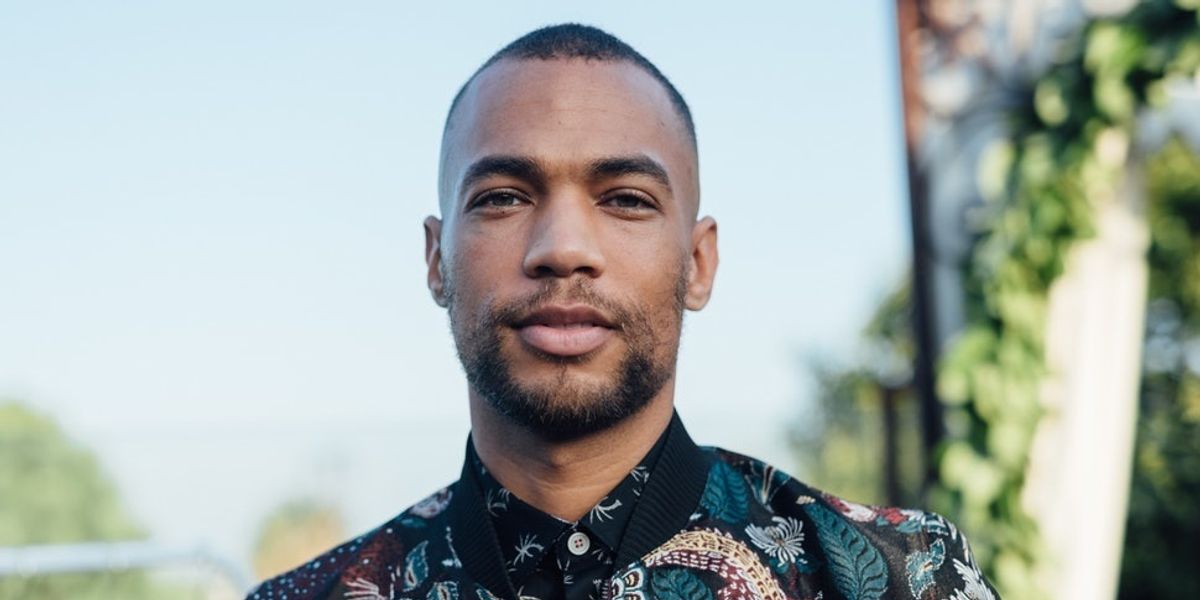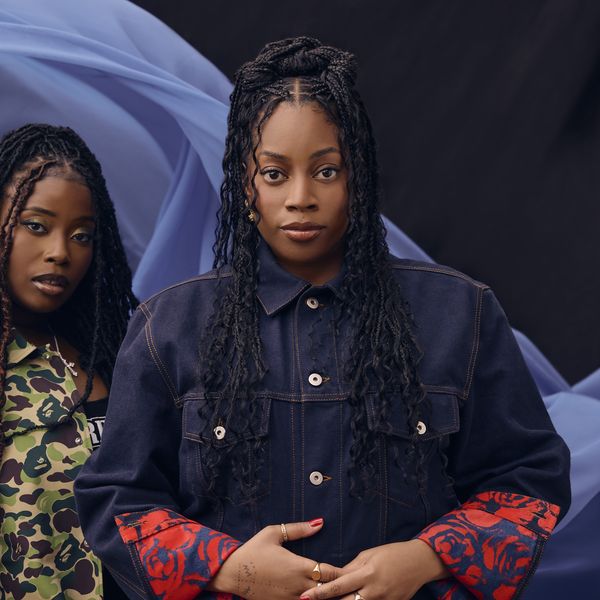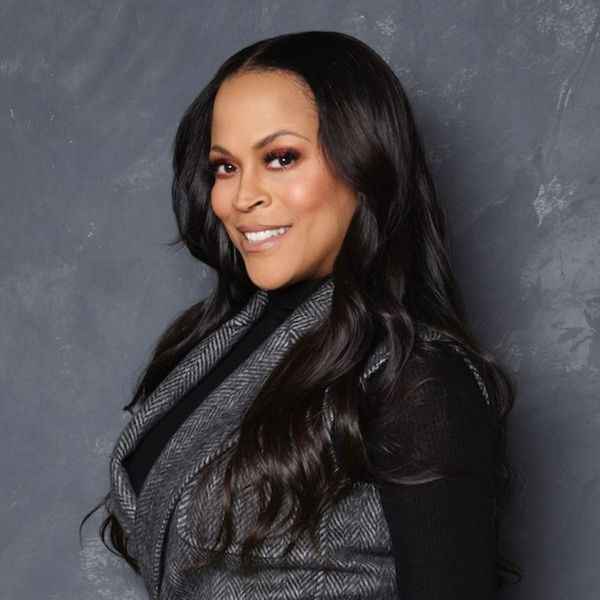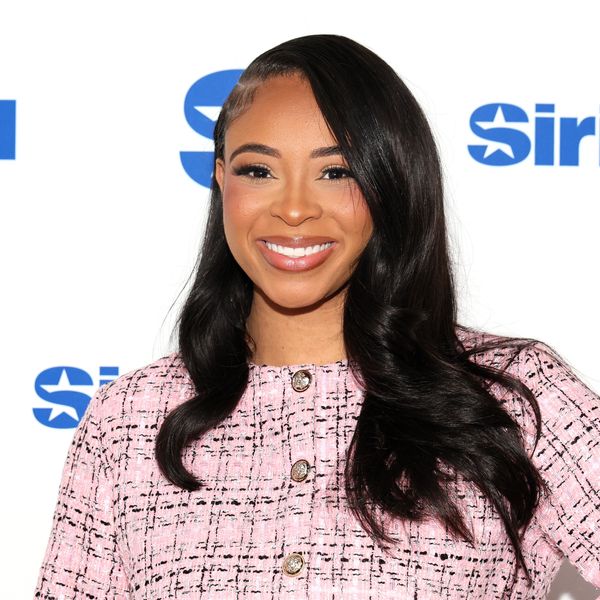
'Insecure'’s Kendrick Sampson Talks Activism & How Everyday People Can Affect Change
If I were to tell you that Kendrick Sampson's journey into activism was inspired by a sign in the bathroom, you wouldn't believe me. But the fact of the matter is, it's 100% true. A simple message, "Leave It Better Than You Found It," became the mantra that the Houston native would eventually tap into in order to shift his activism efforts from a simple act to a revolutionary lifestyle. He is coy yet hilarious as he divulges this story over the phone during a quiet yet busy evening in LA. And as he continues to speak, it becomes more and more apparent that while the impetus may be comical, his dedication to amplifying the voices of those who live in the margins of our society are indeed no laughing matter.
"I have a platform, I have a voice, and I need to do the work and utilize whatever privilege I have in order to keep people from dying. And I can't be complicit in that," he tells xoNecole.
He continues, "It's our purpose, I feel, to leave this Earth better than we found it. And so I really just leaned into that and who I am because it's completely righteous and justified. I've gone about different creative ways in doing it based off what I feel led [to do] and what's most effective, but there's definitely tactics and nuance to all of this."
And tactics and nuances seem to be the main aspects undergirding his new initiative, BLD PWR (pronounced "Build Power"). It's a liberation training, freedom-fighting measure that seeks to leverage the collective power of those primarily in the entertainment industry, to lend their platforms and voices to increase civic engagement and create real shifts towards transformational social justice. In partnership with visionaries such as Tia Oso and Mike De La Rocha, they hope to not only raise up the next wave of socially conscious entertainers but to also foster a safe space that cultivates both imagination and radical love.
We recently got the chance to chat with Kendrick about his new initiative--and here's what he had to say.
In your own words, describe BLD PWR?
BLD PWR is about taking action and how to do that in a healthy way. It asks how do you lift up those vulnerable voices without speaking for them? And how do you learn from your mistakes and what that looks like in a training process? We want to build up the next Harry Belafontes, Marsha P. Johnsons and all these amazing, dope, radical change-makers that were involved in the process and movement. Whatever privilege they had, they aided in uplifting those with a little bit less privilege. Whether it was with their resources, or creatively producing content, or just showing up at marches and protests.
Everybody has their place in the movement and we don't want to give anybody an excuse if they don't agree with people's tactics. We want to train up and foster that imagination. I believe that it's our job, our duty, and our purpose to go into every situation and leave it better than we found it. And to lift up the most vulnerable, seek out the most vulnerable, and empower them and work to liberate them.

Courtesy of Kendrick Sampson
"I believe that it's our job, our duty, and our purpose to go into every situation and leave it better than we found it. And to lift up the most vulnerable, seek out the most vulnerable, and empower them and work to liberate them."
What do you hope to accomplish with this initiative?
Ultimately, people look at LA and Hollywood as a culture beacon. And to be honest, the everyday organizers are the true heroes of our society, the people that dedicate their lives to liberating folks everyday, whether that's in environmental awareness or lessening the maternal mortality rate or closing the pay gap. These people are heroes but a lot of the time, they look to celebrities and people with platforms more than they'll look for the community organizers that are experts in this field or the educators for this information. And so we also have that privilege being in a position where we have people paying attention to us, and my goal is to train leaders within the entertainment industry. So that they'll understand that the real work is on the ground, lead people to their work, and use media attention to reflect and amplify the good work that's already being done.
I want those in the industry to feel confident enough to speak on these issues in the right way. And when they do make mistakes, learn how to correct those easily and not retract back into a corner. I want to have a safe space to where we can foster the radical love and deconstruct all the things we suffer from--talk about it, bounce ideas off [each other] and then push that out into culture.
You’ve been known for your outspokenness and views on today’s social issues as much as your acting. When did you realize you wanted to pick up the mantle of activism? Was there a defining moment: what was it and how did it affect you?
There wasn't a clear defining moment, but I feel like my whole life, I just had this inclination towards trying to do right. And a lot of times it was more so about being right and that was a selfish thing. I think God used that against me to where it was like, 'If you really want to be right all of the time, you need to acknowledge that you're not right. That you don't know everything, you can't be a know-it-all and it's impossible. You need to humble yourself.' So I listened to God in that and try to do my best in allowing that to lead so that I can follow and be an example in that. And it's manifested itself into different ways throughout my life.
Eventually, I was posting stuff while Black Lives Matter was gaining momentum and I was connecting with different movement folks and other people that were socially conscious and getting advice. I was trying to hang back and go behind the scenes and have meetings and such. But then I realized I was placating the oppressor really, in that I didn't want to come off as an "angry black man". And when Eric Garner was murdered and got all this media attention and there was so much injustice and anger--I finally said to myself, 'You know I am angry, I am black, and I am a man.' But if I don't speak out and I try to placate people and not come off as this stereotype, then I'm aiding the oppression.

Courtesy of Kendrick Sampson
"If I don't speak out and I try to placate people and not come off as this stereotype, then I'm aiding the oppression."
The descriptor says that this initiative is: “A National Platform For Artists, Athletes and Entertainers Committed to Using Their Influence For Social Justice.” Do you ever think that there can be art/entertainment WITHOUT activism or are they always one and the same?
Yes and no; it depends on how people understand activism. A lot of people think that every project should be an activism-centered project. They think that there needs to be a protest or a statement on something. And I don't necessarily think that. But I think the way we approach stories should be activism in the sense that our lives are activism. Think about Insecure for example, there's no clear policy that they're trying to push, but it was activism in the sense that it told the story of vulnerable communities that had not been seen before in that space.
And that's so essential and important. So many groups of people of different ethnic groups, genders, and ages come up to me and say they watch Insecure. And now they're privy to an experience that they weren't before. It's not an educational piece, but it helps bring peoples stories to life and humanize them in a way that our society has historically been opposed to. So stories like that, that just tell a simple love story or life story of brown people or indigenous people--that show the humanity in people that aren't normally humanized. That's activism.
"I think the way we approach stories should be activism in the sense that our lives are activism."
Does your acting career play a part in your role as an activist?
I think people think I work a lot more than I do, meaning the projects and they think I'm consistently on set. And unfortunately, I'm not. But a lot of that is because I have to pick and choose what I want to do. Now I'm not gonna sit here and make it seem like I'm picking and choosing all my roles because there are a lot of things that I audition for that I just don't get. But this isn't a woe is me, because I get a lot more work than some actors do--but it is a very conscious effort to not take roles that are problematic, to avoid stereotypes and oppression, misogyny.
I have worked on projects because people are willing to change content, but I definitely think that activism is a lifestyle. And our career should fall under that umbrella. My career is a tool to do that work. Not a side from that work, it's not a side job. It's a part of my purpose and I do my best to utilize every aspect of my life with that purpose.

Getty Images
"My career is a tool to do that work. Not a side from that work, it's not a side job. It's a part of my purpose and I do my best to utilize every aspect of my life with that purpose."
Can anyone take part in BLD PWR or is it just for the aforementioned groups of people?
It's for creatives, but it's not for everybody. In particular, it's with those with platforms or those who are building platforms. There's no size to it but it's for people who are doing socially conscious work--or who WANT to do socially conscious work. So it's writers, filmmakers, storytellers, actors, athletes. It's open to influencers of all facets, but especially within the entertainment business. The main focus is to make sure people with platforms are more informed of the work of everyday organizers and are actually a part of and aiding that work.
When you think of this initiative 5-10 years from now, what do you want it to look like?
I want it to look like an army of freedom fighters. That we're out here building multiple safe spaces, we fostered other people's initiatives and communities, and that we won't necessarily get the credit for it. You won't be able to fully grasp the scope and reach of what we do and manifested in the world. I want it to amplify other people's work, the people on the ground, and in my heart, I want to be able to say, "That's beautiful that I was a part of that and no one will ever know."
But ultimately, [I] want to see safe spaces for the liberation of the most vulnerable folk and people of color, black, brown, indigenous folks and uplifting their stories and bringing them into the center. And having Hollywood lead the charge. Because there is no change, no revolution without art. The most effective communication is art. And part of that is oration and speaking and creating these stories and being active on social media, kneeling. All of that is a part of it.

Courtesy of Kendrick Sampson
"There is no change, no revolution without art. The most effective communication is art."
For someone looking to get more involved in activism or maybe just starting out, what are a few key things they can do RIGHT NOW to affect change?
Figure out what you're most passionate about because we can't cover everything. Find a local community organizer or organization that's working in that area. Because I guarantee you someone is already doing the work on whatever issue you want to take up. Then pursue your education and information in that area. See what the movement landscape is. For those who want to participate in training, they can go to bldpwr.com.
If you're in LA, there's Reform LA Jails, that seeks to transfer millions of dollars that they want to use to build new prisons and invest it into alternatives to incarceration for the homeless and mentally ill.
For more information about BLD PWR, check out their website here. Follow BLD PWR on Facebook.
Featured image by Getty Images.
- Insecure's Kendrick Sampson Has the Best Party Stories About Issa ... ›
- 'Lyft Bae' Kendrick Sampson Looks Like A Snack On The Gram ... ›
- Insecure's Kendrick Sampson Wants to Make Sure You Don't Ghost ... ›
- 'Insecure's' Kendrick Sampson Breaks Down Light-Skinned Privilege ... ›
- Kendrick Sampson (@kendrick38) | Twitter ›
- Kendrick Sampson (@kendrick38) • Instagram photos and videos ›
- Kendrick Sampson AKA 'Lyft Bae' From Insecure On Meeting Issa ... ›
- 'Insecure's' Kendrick Sampson Breaks Down Light-Skinned Privilege ... ›
- Kendrick Sampson AKA 'Lyft Bae' From Insecure On Meeting Issa ... ›
- Kendrick Sampson: 3 Things To Know About 'Insecure's' Newest ... ›
Writer. Empath. Escapist. Young, gifted, and Black. Shanelle Genai is a proud Southern girl in a serious relationship with celebrity interviews, The Fresh Prince of Bel-Air, and long walks down Sephora aisles. Keep up with her on IG @shanellegenai.
How This New Bond Repair Line Transformed One Mother's Postpartum Shedding Into The Ultimate Curl Comeback
This article is in partnership with SheaMoisture
For Crystal Obasanya, her wash day woes came shortly after her son did. The beauty and lifestyle content creator had been natural for years, but during postpartum, she quickly learned about one reality many mothers can relate to experiencing: postpartum hair loss. “Sis had thinning hair. Sis had split ends,” she shared about her hair changes in a Reel via xoNecole.
Over a year into her postpartum journey, Crystal explained she also had dry, brittle hair, noting that keeping it hydrated before pregnancy had already been “a task.” The 4C natural recalled going from thick hair during pregnancy to a thin hairline due to postpartum shedding as “devastating.” When it came to strengthening and revitalizing her hair, the new SheaMoisture Bond Repair Collection was just the thing she needed to elevate her damaged coils to revive and thrive status and get them poppin' again.
SheaMoisture is providing us with the cheat code for transforming dry and damaged strands into thriving and deeply nourished crowns. By unveiling their 4-step hair system, the SheaMoisture Bond Repair Collection is equipping you with the tools to reverse signs of hair damage caused by protective styling, heat, and color and is uniquely formulated for Type 3 and 4 hair textures.
The haircare system revives damaged natural hair by repairing and rebuilding broken hair bonds through a game-changing combination of HydroPlex Technology and AminoBlend Complex, a unique blend of fortifying amino acids formulated specifically for curly and coily hair. Scientifically proven to reduce breakage by 84% and make your hair six times stronger (vs. non-conditioning shampoo), the collection infuses your hair with the nourishment it craves and the strength it deserves.
All five products of the SheaMoisture Bond Collection are infused with natural strengthening ingredients like Amla Oil and fair-trade shea butter. The collection consists of the 4-step breakage-fighting Bond Repair system, as well as the Bonding Oil.
“When trying it out, I quickly noticed that my hair felt revived and renewed, and my curls were so hydrated,” Crystal said while using the Amla-infused Bond Repair Leave-In Conditioner. “I also felt my hair strands were stronger.” So much so that the influencer felt brave enough to get her hair braided shortly thereafter. “I can definitely say that I will be keeping it in my hair wash routine,” she added in the caption of her Reel about her positive experience using the products.
SheaMoisture Bond Repair Collection is making bond-building a key player in your wash day routines and the purveyor of life for thirsty manes. Because who doesn't want stronger, shinier, happier hair?
Step One: Bond Repair Collection Shampoo
Rejuvenate your hair with SheaMoisture Bond Repair Shampoo, your go-to solution for luscious locks. Packed with hella hydration power, this shampoo adds moisture by 60% while removing buildup without stripping your strands. This shampoo gently cleanses impurities while significantly enhancing shine, smoothness, and softness.
The Bond Repair Collection Shampoo is the first step in the 4-step Bond Repair system, all of which are powered by the uniquely formulated AminoBlend, and HydroPlex, SheaMoisture’s technology that rebuilds hair strength at its core.
Step Two: Bond Repair Collection Conditioner
Tailored to repair styling damage, this creamy conditioner locks in 12x more moisture than standard non-conditioning shampoos, boosting damaged hair strength by 1.5x with significantly less breakage. The creamy SheaMoisture Bond Repair Collection Conditioner deeply hydrates, enhances manageability, and leaves your hair looking healthier and shinier.
Step Three: Bond Repair Collection Masque
This Ultra Moisturizing reparative masque is a moisture-rich game-changer for those dealing with the aftermath of hair damage caused by styling. The SheaMoisture Bond Repair Collection Masque delivers 13 times more moisture compared to non-conditioning shampoos, ensuring your hair feels nourished and soft. Designed to repair and rejuvenate, this masque significantly strengthens damaged hair — making it twice as strong while reducing breakage.
Step Four: Bond Repair Collection Leave-In Conditioner
Elevate your curl game with SheaMoisture’s Bond Repair Collection Leave-In Conditioner. Lightweight and hydrating, the Bond Repair Leave-In Conditioner provides 12x more moisture than non-conditioning shampoos and tames frizz with 24-hour humidity control. Designed to define curls and coils, the leave-in conditioner enhances softness and shine allowing you to detangle effortlessly.
Bonding Oil
The SheaMoisture Bond Repair Collection Bonding Oil is a multitasking all-in-one formula that acts as a heat protectant and provides the hair with moisture, strength, shine, damage protection, and intense nourishment. This lightweight oil not only offers 24-hour frizz and humidity control but also fortifies your tresses, making them up to 5 times stronger with significantly less breakage.
Featured image courtesy
Looking for ways to level up your solo sex sessions or your partnered sex play? Entering the wonderful world of arousal oils might be exactly what the doctor ordered. As its name suggests, arousal oil arouses. And they might very well be the pleasurable vessel through which your mind-blowing orgasms can be beckoned. Specifically, arousal oils are a pleasure-enhancing sex lubricant intended to increase the sensitivity to your nipples, your vulva, or your clitoris, just to start.
With an ingredient list that can include the likes of CBD, ashwagandha, and essential oils, arousal oils act as an aphrodisiac in a bottle, maximizing intensity and heightening the levels of pleasure you feel, thereby making your climax that much more attainable.
Keep reading for our selection of some of the best arousal oils in the game right now.
Bloomi Luxe Arousal Oil

Described as a "sensual pleasure oil," the Luxe Arousal Oil by Bloomi is clean with plant-derived organic ingredients. With 2-4 pumps, a gentle massage with this oil-based intimacy oil is formulated to intensify pleasure to your clitoris, your vulva, your thighs, or anywhere else you care to use it, before and during the act.
Foria Awaken Arousal Oil

Not only do reviewers rave about the "incredible o's" from Awaken Arousal Oil, but this best-seller is also known for its sensuous aroma, slip, and feel. With the uncanny ability to enhance sensations, users of the product have reported reinvigorated orgasms and renewed sex lives. And all we have to say is, say less.
Mood Maker Pleasure-Enhancing Intimacy Oil for Couples

Amazon
The Mood Maker had us at hello. Christina Aguilera's sex oil is where luxury and intimacy meet. Thanks to the relaxation facilitated by magic mushrooms and pleasure-enhancing adaptogens, the Mood Maker lays the groundwork for easeful foreplay, sex, and even an encore. With its texture like silk and warm scent, the oil effortlessly sets the perfect mood for pleasure play and allows your body to follow suit.
Lure Deluxe Intimacy Oil

Sultry, clean, and moisturizing are the cornerstones of this intimacy oil. The oil is formulated with organic ingredients like MCT coconut oil and CBD, so there is no need to worry about throwing off your pH balance or leaving behind a sticky residue when using it for intimate moments. The silky texture provides a sensual slip that is all gas no brakes, creating a slip n' slide glide during partner play, as well as solo play.
Bonus points: since it's all-natural, it's also oral-friendly. So Deluxe Intimacy Oil is queening-approved.
Green Compass Intimacy Oil

Green Compass
Entice and awaken your pleasure and your senses with the Intimacy Oil by Green Compass. An intimacy oil made for every body, this oil is fragrance-free, paraben-free, and silicone-free and formulated with plant-based and organic ingredients. With ingredients like organic hemp flower extract, coconut oil, and jojoba oil, the pleasure felt and experienced in intimate areas becomes even more intense upon application.
FOCL CBD Arousal Oil

Loved by users for its "perfect texture," its "warm wonderful feeling," and the fact that it's "non-irritating," the CBD Arousal Oil by FOCL is definitely worthy of a spot in your tox boy. Like other CBD oils, the hemp-derived product is said to ease tension and promote blood flow, which are major keys to enhancing and maximizing your sexual pleasure.
Sensuva On Arousal Oil

Amazon
Looks like we saved the best for last. Available in Lite, Original, and Ultra to give you the ability to choose the intensity that suits your intimate moments best, the On Arousal Oil by Sensuva is said to be one of the most powerful arousal oils on the market with good reason. With a "unique, buzzing vibration sensation on the clitoris," in 1-2 drops, On Arousal delivers more sensation during sex, helps women achieve orgasms quicker and more intensely, and can also help curb any issues with vaginal dryness.
Let’s make things inbox official! Sign up for the xoNecole newsletter for love, wellness, career, and exclusive content delivered straight to your inbox.
Featured image by Getty Images









